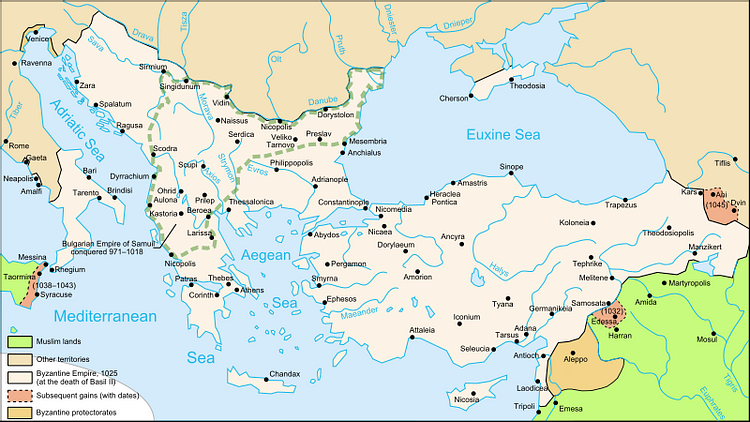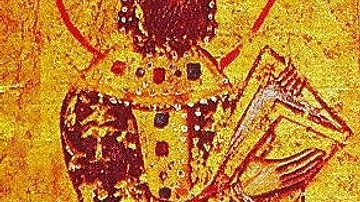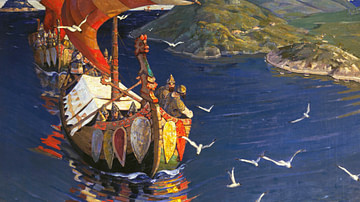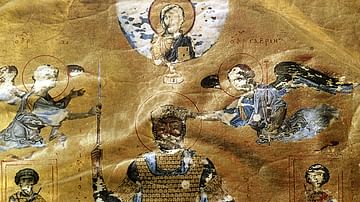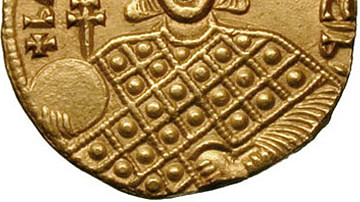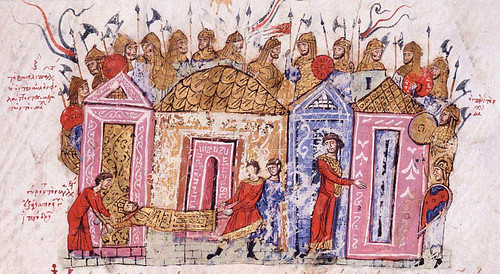
The mercenary Varangian Guard was an elite Byzantine army corps and the personal bodyguard of emperors beginning with Basil II in c. 988 CE. The Viking unit was famous for the stature of its members and their blood-thirsty conduct in battle, where they used their fearsome double-bladed battle-axes to devastating effect. Celebrated recruits include Harald Hardrada, who went on to become the king of Norway, and the Icelandic hero Bolli Bollason. Later, after the 1066 CE Battle of Hastings in England, especially, they became a largely Anglo-Saxon unit. By the beginning of the 14th century CE they had outlasted their usefulness but, for a few centuries at least, the Varangians were probably as shocking a sight to Byzantine enemies as tanks would have been to WWI infantry.
Basil II
Basil II reigned as emperor from 976 to 1025 CE, and despite a hugely successful military career which saw the Byzantine empire almost double its territories, he got off to the worst possible start when his army was wiped out in an ambush by Samuel of Bulgaria at a mountain pass known as Trajan's Gate. The defeat encouraged a rebellion back home when two long-time trouble-makers each sought to take the throne from Basil. One of them, Bardas Phokas, even declared himself emperor in 987 CE. Basil, fortunately, could call on the help of Vladimir I of Kiev (r. 980-1015 CE), who obligingly sent a force of 6,000 Rus Vikings to help the young emperor. They would make all the difference in Basil's ambitious plans to forge an even greater Byzantine empire than ever seen before.
In return for his 6,000 Norsemen and indicative of their value, Basil offered Vladimir his sister's hand in marriage - an unprecedented step for an emperor to offer a royal person to a barbarian leader - provided he agreed to convert to Christianity. This Vladimir agreed to, indeed he went a whole lot further and for his dedicated sponsorship of the faith throughout his reign he eventually became a saint.
The Viking force arrived in Constantinople by sea, and they were a fearsome sight with their long heavy swords and wicked double-headed battle-axes. Basil, after waiting patiently for a year and blockading the rebels, finally made his move and attacked the usurpers' camp. The historian J. J. Norwich continues the story,
In late December 988 the Black Sea lookouts espied the first of a great fleet of Viking ships on the northern horizon; early in 989 CE the whole of the fleet was safely anchored in the Golden Horn and 6,000 burly giants disembarked. A few weeks later, the Norsemen, led by Basil himself, crossed the straits under cover of darkness and took up their positions a few hundred yards from the rebel camp. At first light they attacked, while a squadron of imperial flame-throwers sprayed the shore with Greek fire. Phocas' men, roused from sleep, were powerless: their assailants swung their swords and battle-axes without mercy until they stood ankle-deep in blood. Few of the victims escaped with their lives. (209)
Basil restored order by 989 CE and was so impressed by the exploits of his new Viking army that he made them, first the elite shock troops of his army, and then, his personal bodyguard. The Viking corps became known as the Varangian Guard (“men of the pledge”) and, besides being a tremendously useful unit on the battlefield, they protected many subsequent emperors to the death, much like the elite unit which protected the Roman emperors, the Praetorian Guard. The Varangians were stationed as a distinctive and permanent fixture of the Great Palace of Constantinople. Their arms are described by the 11th-century CE historian Michael Psellos, thus:
These men are, without exception, armed with shields and the rhomphaia, a one-edged sword of heavy iron which they carry suspended from the right shoulder. (359)
The Varangians were certainly effective and dutiful in their responsibility to protect the Byzantine throne, whoever its occupant might be, but the service did not come cheap. One peculiar tradition for services rendered is described by the historian L. Brownworth:
On the night of their sovereign's death, they had the curious right to run to the imperial treasury and take as much gold as they could comfortably carry. This custom enabled most Varangians to retire as wealthy men and ensured a steady stream of Norse and Anglo-Saxon recruits. (212)
Famous Varangians
One of the most famous warriors and leaders of the Varangians was Harald Hardrada who spent a decade in the service of his emperor. Besides many other adventures, he and his fellow Varangians fought alongside the great Byzantine general George Maniakes in Sicily in 1038 CE, capturing both Messina and Syracuse. Exiled under suspicion of plotting an uprising in 1042 CE, Harald fled to Kiev and then returned to Norway where he reigned as King Harald III between 1046 and 1066 CE. Harald, championing his own claim to the English throne, fought and died at the battle of Stamford Bridge in 1066 CE against his namesake, the English king Harold Godwinson.
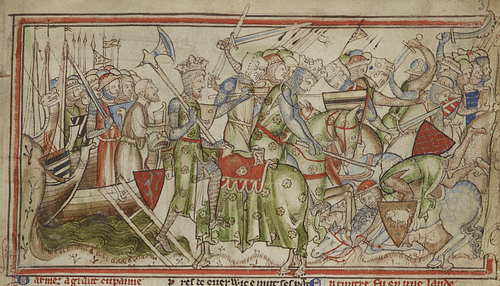
Another illustrious one-time member of the Varangian Guard was the 11th-century CE figure of Bolli Bollason. According to the Laxdaela Saga, Bolli, like his fellow Varangians, was paid handsomely for his troubles and came home to Iceland dressed in such fine gold-embroidered purple robes he earned the nickname of “Bolli the Elegant”.
Following the defeat of the Anglo-Saxons at the Battle of Hastings in 1066 CE, many soldiers travelled to Constantinople to seek a better fortune. More northern mercenaries came from Iceland, Norway and other parts of Scandinavia, attracted by the exploits of men like Harald and Bolli. Byzantine emperors were only too happy to incorporate these travellers into the Varangian Guard although, by the 13th century CE, the majority of its members were English and the Guard used their own language when they acclaimed their adopted ruler.
Decline
The Varangians might have enjoyed a fearsome reputation, but they were not infallible. In 1081 CE, for example, when Alexios I Komnenos was defending Dyrrachion in Dalmatia, he positioned his Varangian troops at the front of his lines, but they were nearly annihilated by an enemy cavalry charge. They did not prove much use in 1204 CE either when knights of the Fourth Crusade attacked Constantinople, although their reason for fleeing the scene might well have been due to their lack of payment. These defeats as warfare and technology moved on may explain why the Varangians became mere palace guards and prison guards from the mid-13th century CE.
A reference to English axe-bearing guards at the Byzantine palace springs up in the work of chronicler Adam of Usk in 1404 CE, but thereafter the Varangians disappear from the historical record. A lasting effect of their presence in Byzantine affairs was the influence of that culture on the guard's homelands, for when they returned after their years of service laden with riches they also carried with them ideas of art and architecture. Finally, there are many rune stones still standing today across Scandinavia which were set up and carved to commemorate the great martial deeds of illustrious members of the Varangian Guard.
